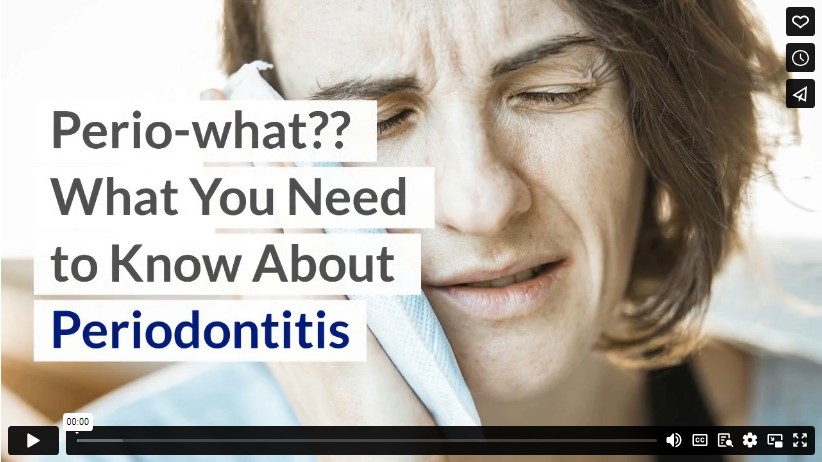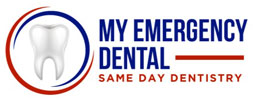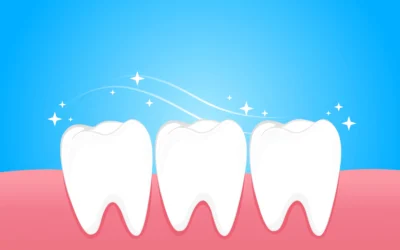Big words and medical jargon can feel intimidating. The last thing you need to feel at a dentist’s office is intimidation. Let’s break down one of those “big” terms that you might hear a dentist or hygienist tossing around.
To make it simple: periodontitis is inflammation.
And inflammation is bad.
What happens is this: Food particles get stuck in those tiny spaces between the teeth and in the pockets between the teeth and gums. Food attracts bacteria, which sends a warning signal to the immune system. That battle cry rallies the immunity troops and they attack the infected area. That leads to all sorts of problems.
Ideally, we avoid this immune response with preventative care. But, we know that “ideally” often doesn’t happen, so it is good to know about treatments as well.
First, it is good to know what to look for. Here are a few warning signs that you might be in danger of periodontitis or periodontal disease:
- Swollen Gums: This is one of the earliest indicators. Your gums might be swollen, painful, or red. That’s a clear sign that your body has seen a problem and is tackling it. Bodies are pretty awesome that way.
- Bad Breath: If you are brushing and rinsing and can’t seem to shake the bad breath, it might be a sign of a deeper problem. Bacteria and inflammation need a bit more than just brushing. You might also sense a metallic taste in the mouth.
- Receding Gums or Loose Teeth: If there is damage to the gums, they might start to get loose or shrink. This can give you the feeling of loose teeth or just elongated teeth.
- Bleeding Gums: This is a clear sign of trouble. If the periodontitis has been ignored for too long, there might also be some pus between teeth. Hopefully, it doesn’t get this far.
A great reason to visit the dentist regularly is that they have a trained eye to spot these problems before they get out of hand. Do you know the saying about an ounce of prevention? It is certainly true when it comes to your teeth.
Still, life sometimes gets in the way. Don’t be embarrassed or worried. Dentists go to school for a long time to help people take care of their teeth. They are there to help – let them. Once you get to the dentist and they diagnose periodontitis or periodontal disease, there are a few treatment options:
- Scaling: This is in-depth cleaning, scraping the plaque, tartar, and bacteria from your teeth. It can be done manually with some basic tools, if needed. Some tools utilize lasers or ultrasonic technology.
- Root Planing: Root planing is similar to scaling, just digging down deeper into the root and base of the tooth and smoothening (planing) the surface of the roots so that plaque is less likely to get stuck.
- Antibiotics: After the scaling and planing, antibiotics might be used to ensure the removal of all bacteria. This might be a topical ointment, a mouthwash, or in some stubborn cases, an oral antibiotic.
These treatments can treat most cases of periodontitis, but some more advanced cases need urgent dental care and more intervention. Don’t panic, dentists work hard to keep these procedures as painless as possible.
- Flap Surgery: This entails some minor cuts in your gums so they can be peeled back to make room for more intense cleaning and scraping. Sometimes periodontitis can cause bone loss, so that can be addressed while the gums are pulled away from the teeth. After you heal up, it will be easier to keep these areas clean in the future.
- Soft Tissue Grafts: If you’ve lost gum tissue to the infection, then a graft can help restore that. Generally, they take tissue from the top of your mouth and attach it. This can cover exposed roots and prevent future loss. Plus, it looks a bit more natural.
- Bone Grafting: Again, sometimes periodontitis can lead to bone loss. If it is extensive, then bones can be grafted as well. What an amazing age we live in!
- Protein Treatment: This is a gel that contains the same proteins the body uses to build enamel and tissue. It can offer support to your mouth as it tries to recover and rebuild.
While all these treatments can be safe and effective, they can also be expensive. Prevention really is the best treatment. None of these will surprise you, but it is worth the review.
- Brush and Floss: Yep, nothing new here, but the basics are the best way to avoid periodontal disease and the treatments it might require. Brush twice a day, using an electric toothbrush if possible, and concentrate on the gum line. Flossing and mouthwash can both be especially helpful in rinsing away any particles you might have missed with your brushing.
- Avoid Alcohol and Tobacco: These have health risks that might seem a bigger deal than your teeth, but your mouth is in danger too. Alcohol is full of sugar, which is especially good at rotting teeth. Tobacco use means unhealthy chemicals passing through your mouth and negatively affecting your teeth. That said, if you do use alcohol and tobacco, following with plenty of water and rinsing will help lessen the damage.
- See the Dentist Regularly: Let the pros do the detective work for you. Their trained eyes will spot problems before you can, and something about going to the dentist regularly keeps you motivated to stay on top of your dental care routine at home. Not just kids want those stickers and a free toothbrush.
Hopefully, you will live your whole life without having to use or hear the word periodontitis. But, now you know more about what it means, what it looks like, and how you can prevent it.
Infographic
Fear is the last thing you should experience when visiting a dentist. It’s a great motivation to go to the dentist regularly since they have a trained eye to see these problems before they get out of hand. If your dentist determines you have periodontitis or another periodontal disease, you have several treatment choices.

Video




